

There’s No Better Place to Make Cider than the Skagit Valley
With the feel of fall in the air some of us just can’t resist the lure of a science project. And there is no better than pressing apples to make apple juice and cider.
Subscribe to the Blog >
By Ginny Bode, Skagit County WSU Extension Master Gardener
Master Gardeners are an inquisitive bunch and are known for their resourcefulness when it comes to making use of the bounty found in their gardens and orchards. From apples to zucchinis, Master Gardeners have multiple ideas for their preservation and use, all capitalizing on our garden’s harvest because after all, what is better than sitting down to enjoy the food and drink you’ve sourced and prepared?
First off, let’s make sure we are speaking the same language when it comes to apple juice and cider. Many of us think of apple juice as the clear juice that we drank at lunch in school. Apple cider was a rich unfiltered juice we enjoyed in the fall. Those terms are no longer accurate in the marketplace. Though many still use the term ‘cider’ to refer to a non-alcoholic beverage pressed from apples and Websters still defines cider as both fermented and non-alcoholic, in the last 10 years the terminology in the US (both legal and popular) has changed to align with the rest of the world, and cider refers to a fermented drink. For this article, the liquid pressed from apples, both clear and with pulp, is referred to as juice and sometimes sweet cider.
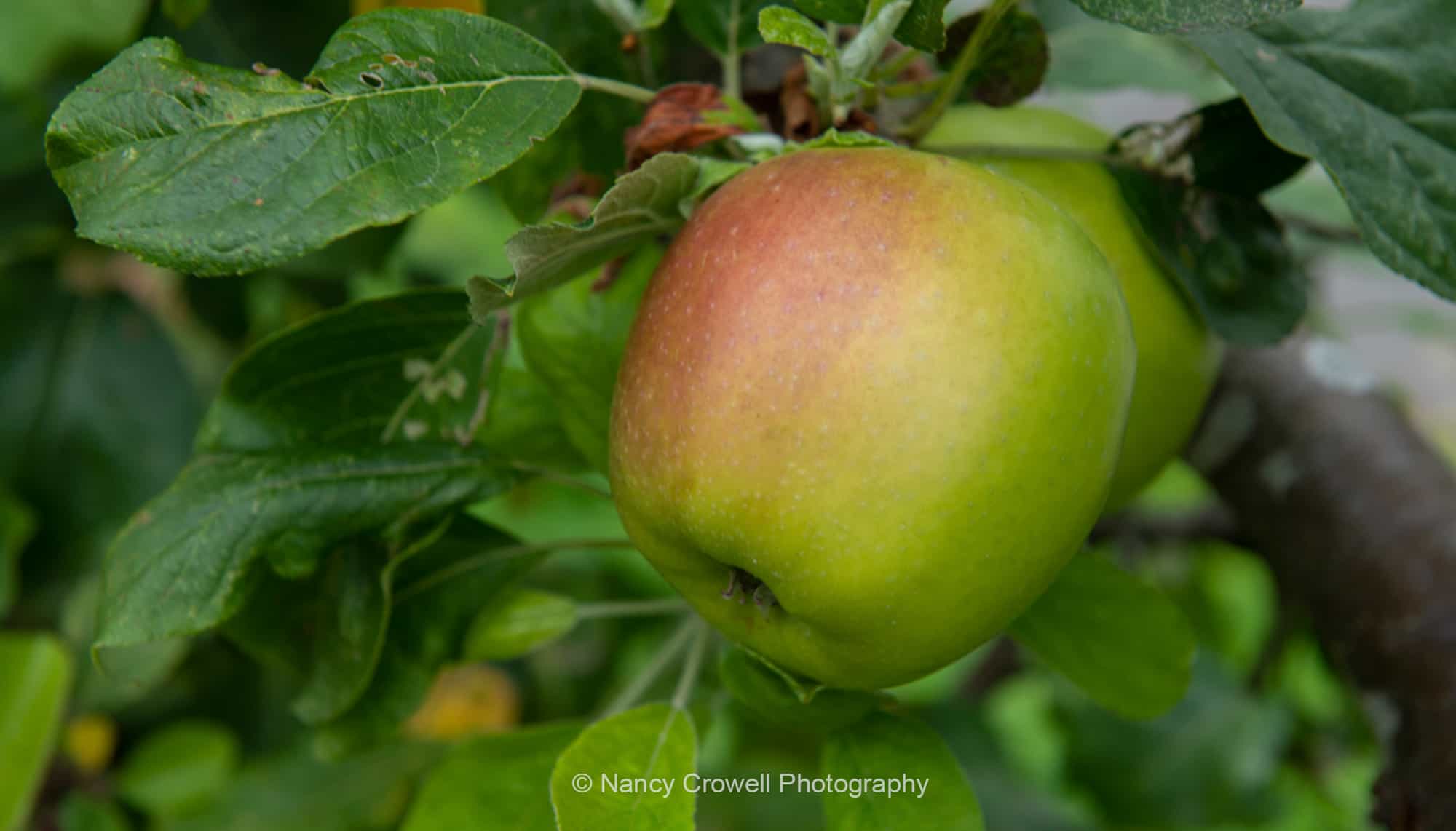
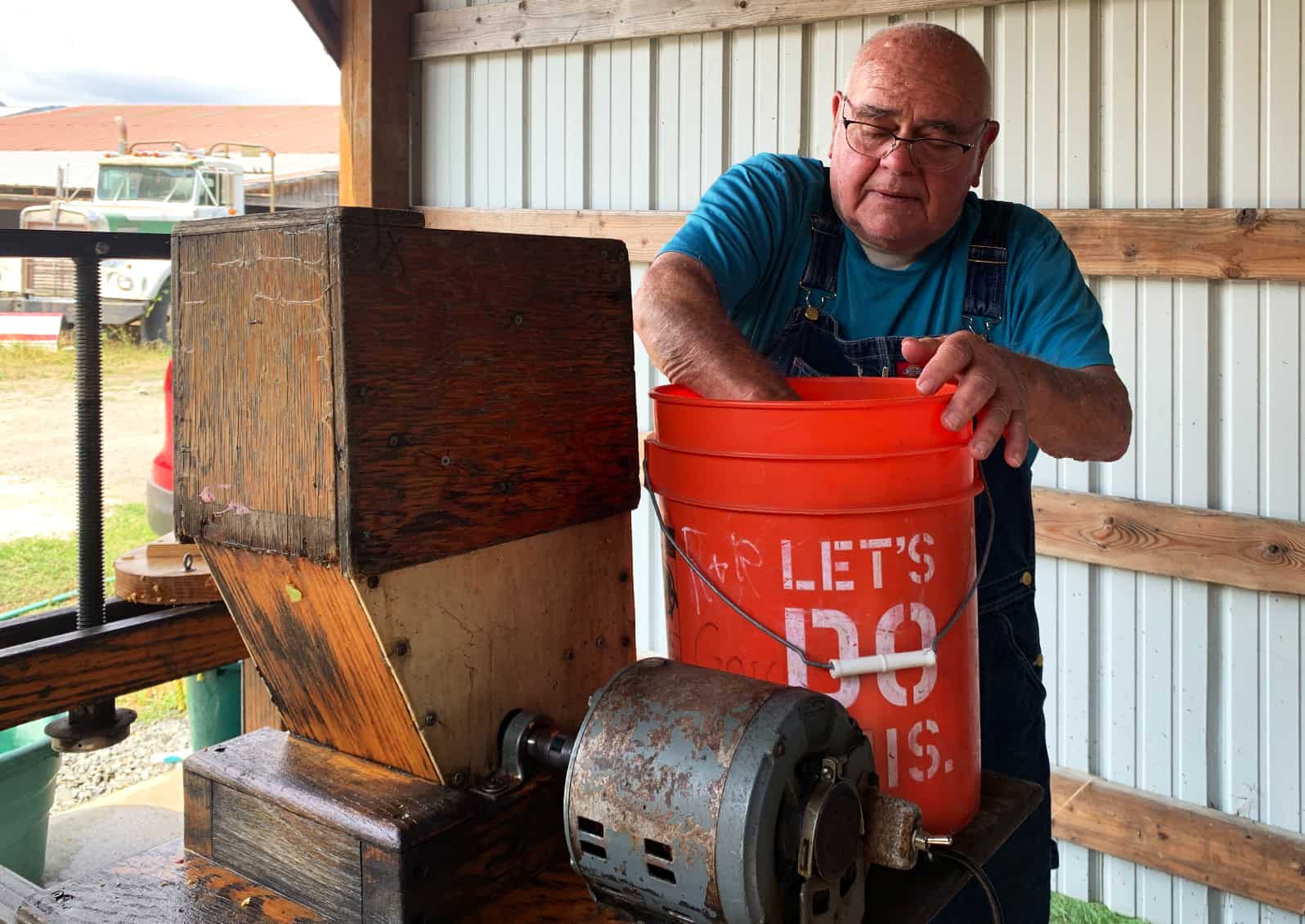
Toby bought his press Correll Cider Press with an electric drive mill more than 20 years ago. He and his friends press 100 gallons of sweet cider each year. © Ginny Bode
While many are content to press their apples to make a pulp-rich juice to drink hot or cold year-round, the juice is also the first step in making ‘hard cider’ or apple cider vinegar. Here we’ll take you through the process of choosing apples and pressing for apple juice and point you to many resources for making fermented apple cider, including that of WSU’s cider research program here in Skagit County.
Choosing The Right Apples For Pressing
Since the settling of America, the northern zones of the US have produced an abundance of apples. Understanding and selecting the right apples for pressing is essential to achieving a delicious and well-balanced flavor.
While many apple varieties can be used and each cider maker has a personal preference, certain types are better suited for cider making than others. Master Gardener Toby Richner has been pressing apples for 40+ years. He believes the key to his success is choosing apples by the season of ripening. Apples ripening early in the season, such as Gravenstein and Pink Lady are tart and considered dessert apples. Ripening later in the season, cider apples such as Kings and Northern Spy produce a sweeter juice because they have been exposed to the sun much longer in the season. Look for apples that possess a good balance of sweetness, acidity, and tannins. He recommends blending apple varieties and possibly adding a ratio of pears to achieve a balanced taste.
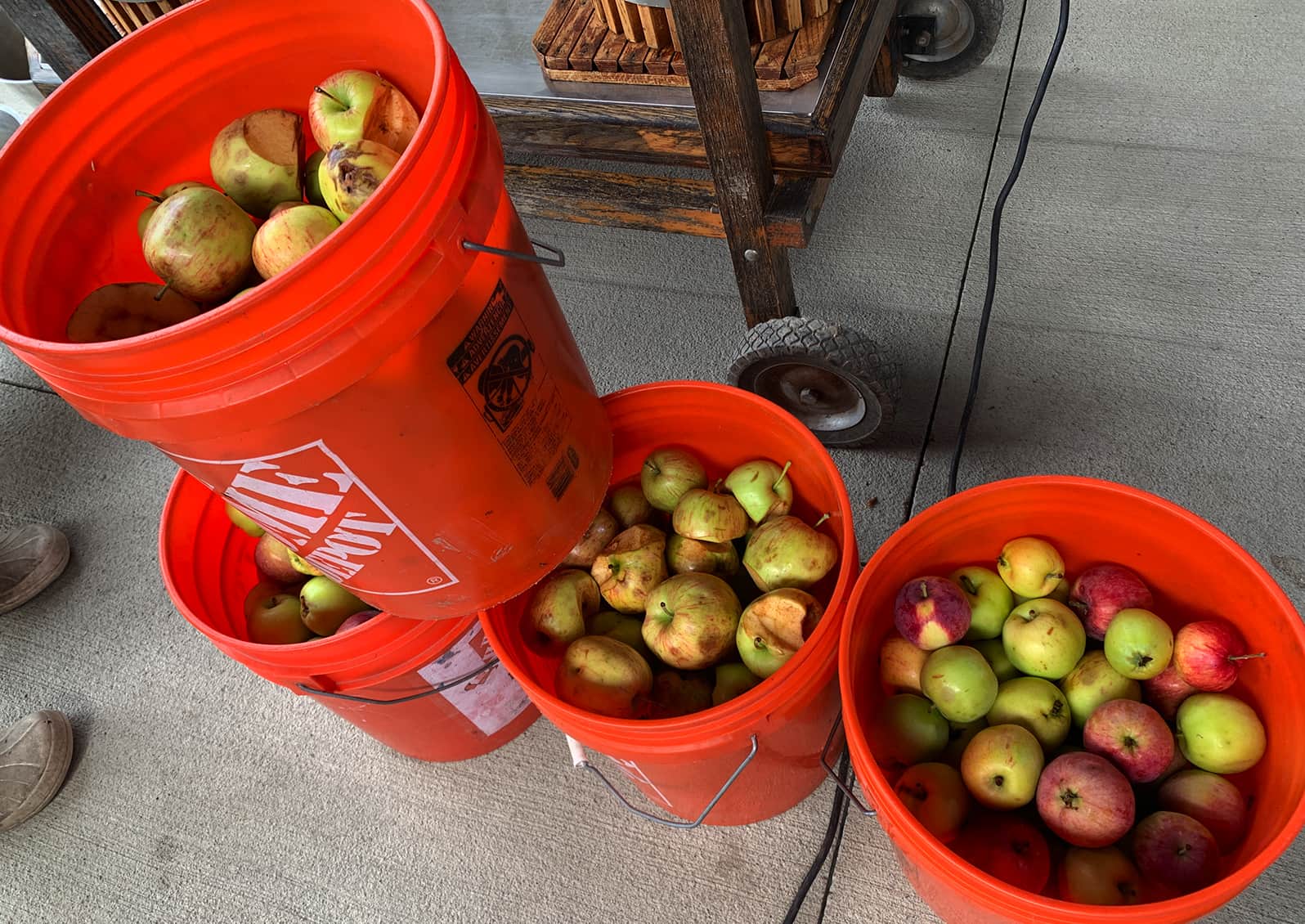
These ¾ full 5 gal. buckets of apples pressed into 2 gallons of cider… plus several glasses for ‘test’ tasting. © Ginny Bode
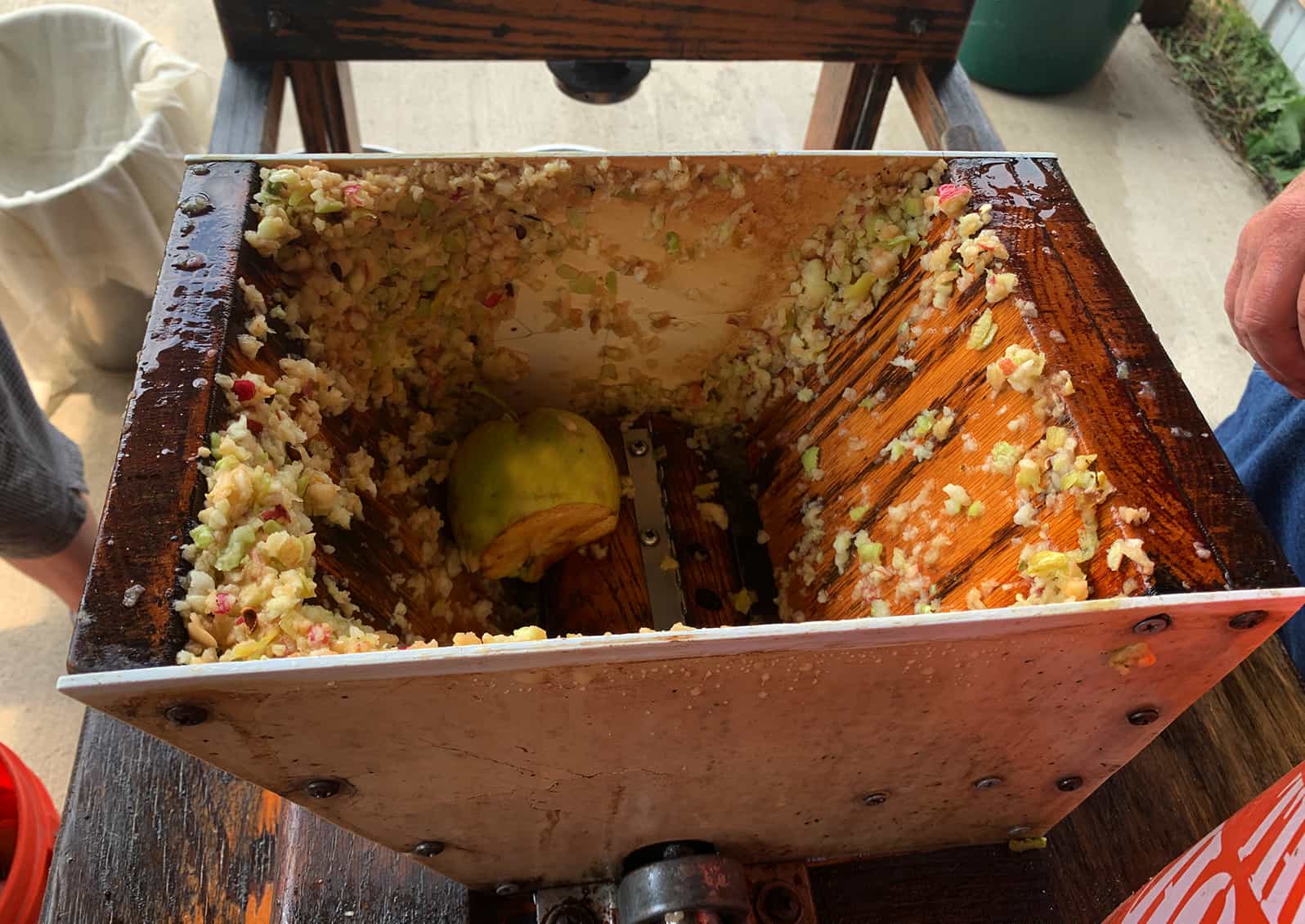
The apples are ground with a mill prior to pressing. © Ginny Bode
At the WSU Mount Vernon NWREC (research center) on Hwy 536 West of Mount Vernon, researchers have compiled a list of 73 cider cultivars-evaluating the apples for their vigor, susceptibility to disease, and quality of the juice for making cider. Though the study is intended for commercial growers the list is helpful when selecting the best apples for your project. https://cider.wsu.edu/ciderweb/
You will need thirty to forty apples to press a gallon of juice. The volume of apples needed to produce many gallons of apples can be cost-prohibitive for the hobbyist unless one has access to an orchard, or can source apples from friends and neighbors. Toby Richner sources the apples needed for the 100 gallons of cider he and his friends produce by relying on years of relationships developed through trading apples for gallons of fresh pressed juice.
Windfall vs. Picked
Many home cider-makers believe windfall apples, those which have fallen due to ripeness and wind, produce the best cider. Scientists say using windfall apples safely depends on how you intend to use the juice-drinking immediately or processing to make hard cider.
If pressing for sweet cider only, WSU Masters student Seth Brawner, working on cider research here at WSU Mount Vernon NWREC, recommends against using windfall apples. He says, that even if pasteurized, the toxin patulin can survive in the juice and cause people to get sick. To avoid this, only use picked apples in sweet cider. Seth goes on to say, “If using your pressed juice to make hard cider, windfall apples can be used because fermentation is considered a “kill step” because the alcohol produced during this process will destroy patulin and eliminate pathogens in the cider.”
When using windfall apples, take extra vigilance. Always cut away any areas bit by deer or other critters, dispose of any rotten or wormy areas, and wash thoroughly in a chlorine bath. Poor-quality fruit will diminish the taste of your cider. Michigan State University Extension has produced an excellent food safety guide referenced below.
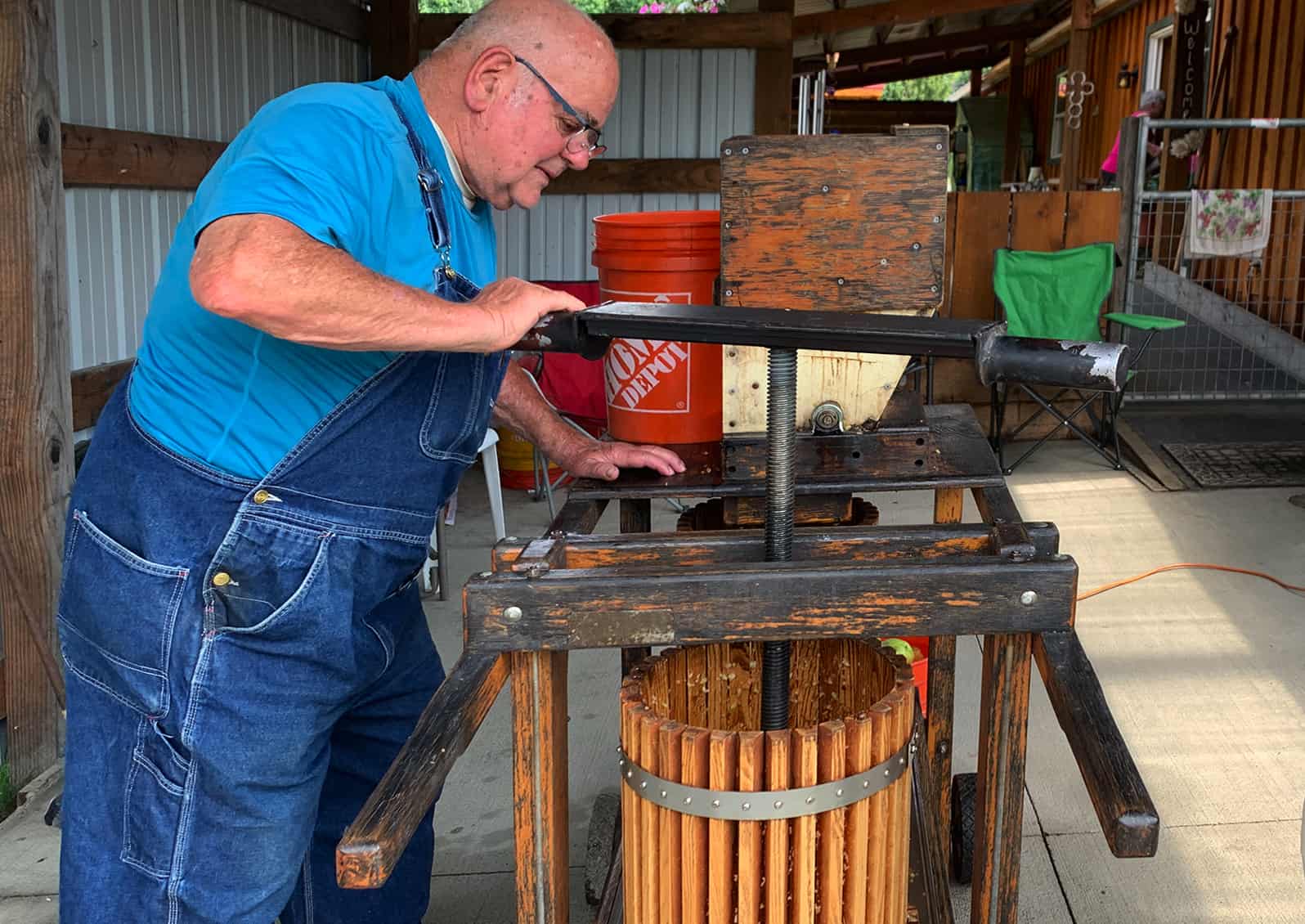
Master Gardener Toby Richner has been making sweet cider for more than 40 years. Beyond enjoying great cider year around, he enjoys the community they’ve built trading apples for fresh pressed cider. © Ginny Bode
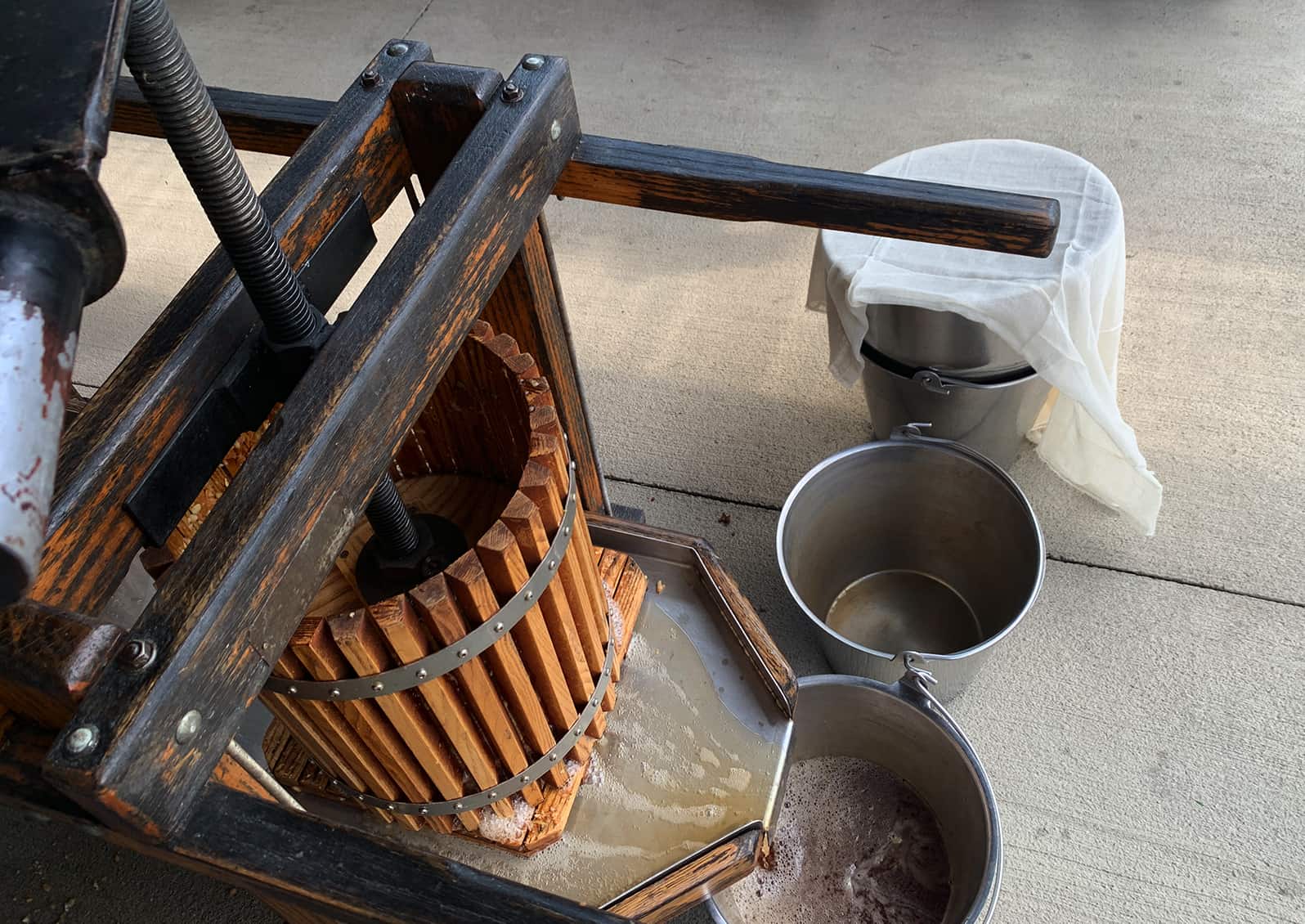
The press bears down on the milled apples to release the juice which flows into food grade containers-in this case, stainless steel buckets. © Ginny Bode
Equipment Needed for Homemade Sweet Cider
Along with apples, to embark on your home cider making journey you’ll need:
– Cider Press– to efficiently extract the juice from the apples.
– Food processor or grinder– to break down the apples before pressing.
– Large food-grade vessel- a 20-30 gal container for mixing juice before bottling
– 2-3 gal. food-grade buckets for ‘catching’ the juice as pressed
– Jugs and/or bottles – for storage
There are various methods for pressing apples available, ranging from simple hand-pressing techniques to using a specialized cider press. The cider press is the most efficient method of crushing the apples and releasing their juice while leaving behind the pulp and seeds. Home presses are available in many sizes and styles ranging from $100 to over $2000.
Preparing the Apples For Pressing
Start by washing the apples thoroughly to eliminate dirt or debris. Inspect each apple for any signs of damage or rot. Remove any spoiled fruits to ensure the quality of your cider. After cleaning, quarter the apples into small pieces, then, keeping the seeds and stems, grind them with a food processor or mill.
Pressing The Apples, Extracting and Storing the Juice
Now the fun begins-pressing the ground apples to obtain their flavorful juice. Capture the juice as it flows from the press. Strain the juice through a fine mesh, sieve, or cheesecloth to remove any remaining solids that may have slipped through the press. Transfer to clean jugs with airtight lids, leaving headspace for expansion when freezing. If you don’t have room in your freezer, the juice can be preserved through the canning process. Refrigerate if you plan to drink right away.
Commercially sold juices and sweet ciders are usually pasteurized for food safety purposes. Many home juice and cider-makers believe unpasteurized juice retains more flavor, vitamins, minerals, and antioxidants. Though pasteurization doesn’t completely eliminate the risk of foodborne illness, it does reduce it.
The Fermentation Process: Taking the Next Step to Cider
When the apples have been pressed and the juice made, the real science project begins – the fermentation process. This crucial step is what turns pressed apple juice into flavorful and aromatic cider.
Adam Coy started his cider making adventure in his garage. He is now the cider maker for Farmstrong Brewing’s Ragged & Right Project in Mount Vernon. Coy says “cider making is fairly simple when you break it down. You need juice with a fair amount of natural sugar, a clean vessel to put it in, and a little yeast to start it all off. It should be kept cool, but not overly cold/freezing. Then it’s just a matter of time to let the yeast do its work. With just a few basic tools, anyone can make cider at home.”
He started home brewing, referring to it as an adult science project. And like many cider makers, he bought the juice from a local orchard and found the basic supplies at the local brewing shop: a 6 gal. carboy (water cooler style jug); water lock and stopper; a hydrometer; a siphon and a thermometer.
Master Gardener Bob Bryan does the process from start to finish using apples from his orchard to create the cider. Filling the 6 gal. carboy with fresh pressed juice, he then lets the sediments settle out overnight before getting started. He uses sulfur dioxide (SO2) to kill the microorganisms in the fresh-pressed juice. Then within 12-24 hours adds his preferred strain of yeast. The yeast consumes the natural sugars and converts them to alcohol. Both Bryan and Coy equate cider making to wine-making and enjoy the process of constantly measuring and maintaining proper temperature and oxygen levels to ensure successful fermentation.
The exact steps to the fermentation process can be found at https://cidersage.com/tutorials/hard-cider-making-tutorial/ or in WSU’s publication Hard Cider Production and Orchard Management in the Pacific Northwest. (https://pubs.extension.wsu.edu/hard-cider-production-and-orchard-management-in-the-pacific-northwest/)
Once a prominent part of American culture, cider making in the US is experiencing a resurgence in consumer demand with a 30-fold increase in the number of cideries. Skagit Valley is home to one of the main US apple research programs at WSU Mount Vernon NWREC and is an excellent place to start your cider making journey.
 RESOURCES AND FURTHER LEARNING:
RESOURCES AND FURTHER LEARNING:
If you are highly interested in furthering your hard cider making expertise, the Cider Institute also offers online and in-person courses, including one offered in Mount Vernon in December of 2024. https://www.ciderinstitute.com/courses#Courses
https://cider.wsu.edu/ Washington State University
https://hardcider.cals.cornell.edu/ Cornell University
A brief history of cider in the US: https://cider.wsu.edu/history-of-cider/
https://www.agbizcenter.org/resources/all-things-cider/
https://www.nwcider.com/ Northwest Cider Association (NWCA) is a regional group of cider makers and orchardists from the PNW and British Columbia.
https://www.canr.msu.edu/news/its_cider_time
Sprague, S. and Venema, C.; Michigan State University Extension – November 22, 2022
https://www.canr.msu.edu/news/pasteurized_or_unpasteurized_juice_whats_the_difference
Nichols, J., Michigan State University Extension – September 12, 2014

Ginny Bode
ABOUT THE AUTHOR:
Ginny Bode is Skagit County WSU Extension Master Gardener and Co-editor of the Ask a Master Gardener Blog.
_________
Questions about home gardening or becoming a Master Gardener, may be directed to: Skagit County WSU Extension Office, 11768 Westar Lane, Suite A, Burlington, WA 98233; by phone: 360-428-4270; or via the website: https://extension.wsu.edu/skagit/mg/